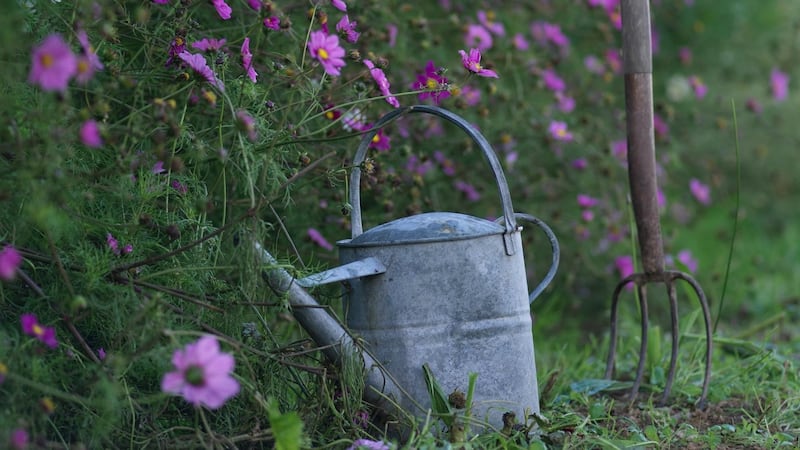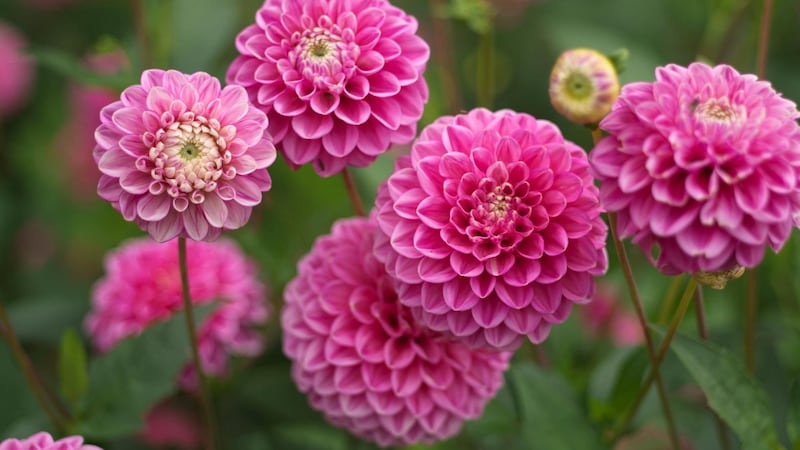Phew. It’s finally over. Or at least it’s over for now.
By which I mean this summer’s prolonged drought and searing temperatures, a testing time for all Irish gardeners but especially for those living in the east and south where rainfall levels were as low as 5 per cent of their seasonal norm.
A measure of its severity is the fact that although recent rainfall has finally begun to replenish our parched soils and growth levels are slowly recovering, a nationwide hosepipe ban remains in place until the end of this month at the earliest, possibly into October.
But with these sorts of extreme weather events predicted to occur with increasing frequency in the future,what have we learned? As climate change forces us into previously uncharted waters and we search for adaptable, sustainable ways to garden for the future, here’s a look at some of the gardening lessons we need to take from the long hot summer of 2018.
No no amount of diligent watering, even when done in the cool of the evening to maximise its effects, is going to be as good for plants as sweet, clean, cool Irish rain falling from the sky. Ever.
But when you don’t have that, then harvested rainwater is not only a far more sustainable alternative to tap water, but is also much better for your plants. This is because tap water (if you’re on a mains supply) almost certainly contains chemicals such as chlorine and fluoride, which can build up in the soil and inhibit healthy growth.
For the same reasons it’s not good for pond life, which is why harvested rainwater should also be used to top up any garden ponds. There are many different ways to harvest rainwater including sophisticated integrated systems, some involving pumps and filtration systems. But at its simplest and most affordable, it’s a very straightforward matter of installing rain barrels/water butts, which can be easily sourced from good garden centres and local authorities.
Soil mulches are crucial in terms of forming a protective, cooling skin to help keep moisture in the ground and prevent excessive evaporation during very hot, dry weather.
The best are organic – examples include well-rotted garden manure, homemade garden compost, leaf mould, worm compost, grass clippings, chopped straw or bark (but only use the latter on paths or around established trees/ hedges).
These will also slowly break down over time to hugely help improve soil structure, health, fertility and its ability to retain moisture. The ideal time to spread these mulches is in autumn or late spring when both soil moisture levels and soil temperatures are high.
Bare skin
I’ve also seen Irish gardens that have staunchly withstood this summer’s severe drought by use of a shallow inorganic mulch of fine pebble or horticultural grit, sometimes spread over the weed-suppressing fabric known as mypex. Conversely, the Irish gardens/allotments that left lots of naked soil (think of it as soft, bare skin unprotected by clothing or suncream) exposed to the searing summer sun were the ones that suffered the most.
Lawns are one of the most resilient forms of plant life in any garden, capable of regenerating remarkably swiftly once rainfall arrives. So while a dusty yellow-brown sward may not be the loveliest looking thing, don’t waste any precious water on it. It will recover.
Also healthy, well-established, deep-rooted trees, shrubs and perennials (especially the tap-rooted and bulbous kinds) are always going to cope far better with drought than short-lived annuals whose root systems need ideal conditions for optimum growth.

But if you love to grow the latter like I do, then make sure to prepare the ground really well before planting with the addition of plenty of organic matter and powdered seaweed (proven to help plants withstand drought and heat), to slightly cup the soil when planting to create a slight hollow (this will help to hold water around the roots), to mulch around plants immediately after planting to conserve soil moisture, and be prepared to water young plants during prolonged drought periods. This is especially true in kitchen gardens, where many of the edible crops are short-lived fast-growing annuals.
Gardens containing shrubs and trees are not only better for the environment but are also much better able to survive periods of drought than those without, as their leafy canopy acts like a giant protective sun parasol for smaller, more vulnerable plants growing beneath them as well as for the soil.
Gardens managed organically are far more resilient in the face of drought because the health and structure of the soil hasn’t been compromised or damaged by the repeated use of fungicides, herbicides, insecticides and artificial fertilisers while the regular addition of organic matter and other soil enrichers such as seaweed dust and biochar (a natural soil amendment in use for thousands of years) also greatly improves soil water availability in these gardens.
To find out more about biochar and its near-wondrous effect on soil health and fertility, see http://biochar-us.org/ and eoinbracken.com (the latter website explains how to build your own biochar kiln)
Loathe winter
While we’ve had a ferociously hot, dry summer, there is no point in replanting our gardens with lots of the sorts of heat-loving, drought-tolerant Mediterranean species that loathe winter wet and cold.
Just remember the sunless and wet summer-that-never-was of 2017 plus the endless icy winter that followed it. But the good news is there are many other kinds of plants that have surprised Irish gardeners with their easygoing tenacity in the face of this summer’s heat and drought, and yet which also happily tolerated 2017’s cool, cloudy wet summer and the awful winter that followed.
Examples in my own garden/ flower farm include varieties of Clematis viticella, alchemilla, veronica, linaria, crocosmia, amberboa, knautia, dianthus, verbascum, campanula and stipa, none of which were watered.
Other Irish gardeners that I’ve spoken to have singled out dierama, lilies, veronicastrum, rudbeckia, Lysimachia clethroides and persicaria.
In short, always bear in mind that oft-quoted mantra of seasoned gardeners, which is ‘the right plant for the right place’. If in doubt, do a little online research into a species’ natural growing conditions in the wild, which always offers a very good clue.
This Week in the Garden:
Buy seed of hardy flowering annuals such as cornflower (Centaurea cyanus) , Queen Anne’s Lace (Ammi), Love-in-a-mist (Nigella), honeywort (Cerinthe), orlaya and Californian poppy (Eschscholzia) for sowing later this month.
Recommended suppliers include all good online garden centres while great online Irish stockists include mrmiddleton.com and seedaholic.com Autumn-sown hardy annuals will overwinter to produce stronger plants with more resilient root systems that will flower earlier and for longer next summer.
If you grew sweetcorn this summer in your garden or allotment, then the cobs should be beginning to ripen.

To tell if they’re ready for harvesting, gently peel back the edges of the protective green sheath enclosing each cob and check if the ‘silks’ (the cob’s threadlike tassels) have begun to go brown and shrivel up and that the individual kernels are deep-golden in colour. Then use your thumb to press down firmly on a few kernels and examine the colour and texture of the resulting juice. If it’s clear, then it’s not yet ripe. If it’s milky-white, it’s ready to pick. If it’s very white, thick and almost floury, then it’s past its best.
At this time of year many plants in the vegetable and flower garden are now so large that they need support/careful staking to prevent them from being badly damaged by heavy rain and/or strong winds.

Examples include dahlias, lilies, chrsyanthemums, cosmos, bells of Ireland, sunflowers, second-flush, delphiniums, wolfbane, eupatorium, sweet corn, tomatoes and broccoli.
You can do this using purpose-made plant supports available from all good Irish garden centres or lengths of bamboo cane and garden twine. If using bamboo canes, make sure to cover the top of each cane with a safety cap/ cane topper/ upturned small garden pot to help prevent accidental eye injuries while weeding/ deadheading.
Dates For Your Diary:
From today (Saturday August 18th) to Sunday August 26th, The Teak House, National Botanic Gardens, Glasnevin, Dublin 9, 'Totally Terrific Tomato Festival' with an extensive exhibit of many different kinds of rare and heritage varieties of tomato, lectures by the garden's director, Dr Matthew Jebb (Saturday August 18th, 11am) and the event's founder, the Dublin-based tomato enthusiast and organic grower Nicky Kyle (Saturday August 18th,12pm) and interactive children's workshops on growing, cooking and eating tomatoes with Deirdre Doyle of the Cool Food School on Sunday 19th August (11am and again at 1pm) and Saturday 25th August (11am and again at 1pm), see botanicgardens.ie for details.
Also today, Saturday 18th (from 2pm) and tomorrow Sunday 19th August (from 3pm), ‘Garden Vista’, Chanel College, Coolock village, Dublin 5, a two-day flower show held by Dublin 5 Horticultural Society with extensive displays of roses, dahlias, cut-flowers, vegetables, fruit, baked goods and artwork.
Also tomorrow, Sunday 19th August (from 11pm), Hunting Brook gardens, The Lamb Hill, Blessington, County Wicklow, 'Full Bloom', a celebration of the garden in full bloom with a talk on salvias by garden owner and salvia obsessive Jimi Blake at 12pm, a guided tour of the garden by Jimi with the focus on his favourite plants for August (2pm), a talk on growing/ using cut-flowers from the garden by Fionnuala Fallon (3.30pm)and specialist plant sales, see huntingbrook.com.
Saturday, 25th August (3pm-5pm), Delgany & District Horticultural Society’s ‘National Dahlia Show’, St Patrick’s National School, Church Road, Greystones, Co Wicklow, entries welcome, see delganydhs.com for details






















